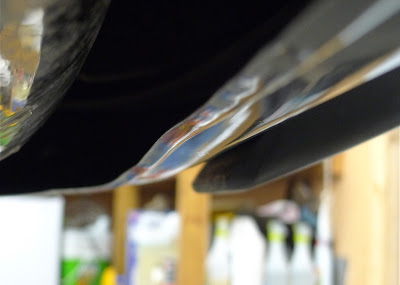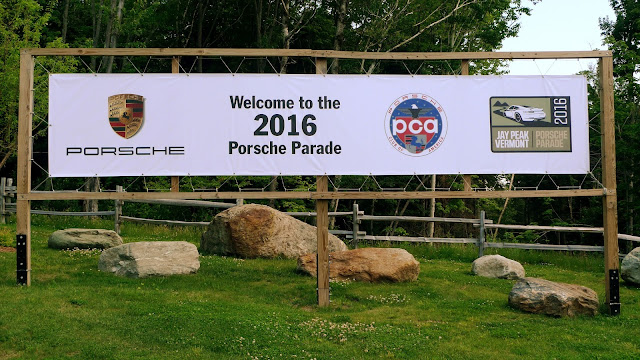Of course, you want it to look nice. An old classic car that you are proud to own, work on yourself, and want to keep, needs to look presentable if you are a more-or-less normal person.
Doing your own work on mechanical issues can be accomplished with methodical attention, but when it comes to the aesthetic perfection of well-painted, well-polished, well-assembled body bits - inside or outside of the car - then Art on some level comes into play. For me, this is where the process turns into a forbidding exercise, as opposed to simply a scary one, such as rebuilding the engine (!)
The reason for this is that when a car is of a certain advanced age, and has paint of an unknown colour - one that's not the cars' original hue, and which bears no identification code - then you are out there, on your own, but are freed to imagine and dream whatever you want, somewhat. The trick is to have it 'work' and look just as good as Porsche's original effort, if not an improvement on that. Naturally, my objective is to make better what is before me, thereby calling upon the various muses who are in charge of the Art department. Help, I say.
That's a pumped up statement, of course, but it's the product of the challenge I see. If I don't get it right, I'll call it Art. . . I said it's intimidating, because any obvious, or unfortunate variation from the Porsche original will sit squarely on my shoulders and be subject to disfavour, whereas mechanical 'upgrades' are ordinarily the focus of appreciative discussion. Then again an assessment of the Art part is usually subjective, anyway, because there are no absolutes to measure against. However, an analysis of the Fine Art of something, even, possibly, on a car, ought to be the object of an informed and well reasoned evaluation. But, Art isn't easy if it's the real thing. All of this said, car work, no matter how well it is done is not Fine Art, but rather sophisticated artistry and craft of a high order; worthy of earnest appreciation, as is excellent design. Sometimes these lines blur, but that would be decidedly rare.
So, in a moment of enthusiastic backing-up of my 911, I bumped into a short and invisible post. I put a small scrape into the lower edge of the rear bumper, and a robust dent into the valance beneath it. Damn, and I forgot to take a picture. In the shop I unbolted the valance and pounded out the dent. I did a good job of it, too; smooth. The paint, on the other hand, was fractured and there were four small cracks in bolt holes and along the upper edge of the valance, maybe those were from vibration. There were a good number of stone chips in the painted surface, as well as in the 'undercoat' on the back side. It needed a complete work-over.
The original colour of my car was Gazelle metallic, a kind of gold; now it mostly resembles Porsche's Meteor Grey metallic from about a decade more recent than my car, but it's not quite that colour either.
In a nearby town there is a body shop that does good work. I used them after hitting a deer with the Subaru, and the end result was perfect. I could not find where the work had been done, and the colour matched, exactly. Not real Art, but excellent workmanship. This shop does a lot of 'special' cars. There is usually a Viper in there, or a 356 outlaw coupe (see my December, 2014, post about a 356 outlaw) and yesterday, a Triumph TR7 coupe in fresh British racing green. I went there with my damaged valance under my arm.
The 'bodywork' part of the job is straightforward I said, but how do you match the unknown paint? "No problem. We have a scanner and can match any colour perfectly," they said with a grin. "There's only about three hours of work in that, plus the paint, so it won't be too expensive." I knew the cost of an aftermarket reproduction part, plus shipping, plus painting, plus the work . . . I told them to do the job, because I knew that it could only be perfect.
 |
The metallic flecks are much smaller on the bumper at the top. Below is
the repainted valance with more bling. Click to enlarge. | | |
It was done in a few days and it was presented to me completely swaddled in bubble wrap, which I peeled aside to see a shiny new painted surface; I paid and left, but the valance remained on my workshop bench for a fair number of days until I could get around to it. Finally I bolted it back onto the car and took a critical look at the thing. Oops. The metallic particles in the paint didn't look right (too big), and the colour was a tiny bit off. That, and there is a wobble along the bottom edge in the area where the dent used to be. Good thing that the valance lives underneath the rear bumper. Nobody looks down there, so I'll leave it, but I'll be less apt to recommend that shop as often.
To be fair, getting things right with something as malleable as car sheet-metal is a tough trick, especially when the rest of the car isn't present, so I can understand the wobble on some level. But, matching the colour of the object in hand by means of a fancy scanner whose only job is to match colour should be a no-brainer. I'll see if I can photograph what I mean about the big metal particles, and the wobble.
 |
| Looking down the length of the wobble. Not good. |
It takes real effort to do high-level bodywork. There is a famous car painter, named Emil 'Butch' Brinza. He must be retired by now, and living in California, or Arizona, although he originally got into the car painting profession back in West Allis, Wisconsin (a component section of Milwaukee). I'm originally from Wisconsin, and although I didn't know Mr. Brinza personally, his shop was a short way from the differing shop of a very good friend of mine, who used Brinza's services on occasion, for interesting cars that he owned. People shipped cars and bikes from all over North America to Butch's shop, asking him to paint them.
One of the stories I best remember involved a brand-new Rolls Royce Silver Shadow (I think). The car was painted super-deep 'Masons' black, that you would only see on a Rolls. However, this new Silver Shadow's owner thought that the car's factory paint was sub standard, and he demanded that R-R do something about it. Rolls Royce saw the customer's point, but having no painting shop of its own in North America, R-R naturally shipped the new Rolls across country to Butch Brinza's shop. They asked him to tend to the paint in a correct manner. (The black paint cost $190 U.S. per U.S. gallon in 1967. That comes to about $480 per gallon in 2016. Fancy paint.)
 |
| A 1967 Rolls Royce Silver Shadow. |
Never one to take half measures, especially with such an invitation, Butch stripped the car down to the bone, because he also felt that the paint was not worthy of such a car. I'm talking taking the windows out; everything. What he discovered was that R-R had not cleaned the metal properly, especially where seams existed between various body panels, and that there was emerging rust in an assortment of places on that brand-new Rolls Royce. He did a proper job of the 're-do', and the car was shipped back to its owner. The owner was thrilled, because Butch's work was so superior to the original Rolls Royce paint. He was the best in the business, Butch was. R-R hadn't worked hard enough.
Butch didn't use a colour scanner, and he did real physical work. Sanding and polishing entirely by hand was the only method that got proper results in his view, and that seems to have been correct, or else his work would not have been so highly regarded.
 |
| You have to read this. Click to enlarge. © = Harley D? |
In other words, actual work still is needed to get acceptable results when you look closely at a special interest car. Modern, automated methods do not always cut it.
Then again, simple creativity comes in handy, too. My Porsche has a mysterious round hole in the engine tin. At least I didn't know what that hole was for, although I recently learned that it is for part of the air injection system that my car doesn't have. My plan was to plug the useless hole, but Porsche doesn't sell such a plug, and probably no one else does, either. My dog, Wilber, provided the answer. Wilber likes his dog food, so I routinely have to open a can of the stuff and the cans are, surprise, round. That, and they are coated with an anti-corrosion material, plus the ends of the can have ribs to reinforce the light metal. Perfect.
I painted the lid (actually I used five of them before I got it right), poked a hole in the middle, and installed it in the car. It looks appropriately stock to me. Wilber is proud of himself.
 |
| That hole is the hole in question. |
 |
| Looks OK, in a quirky way, thanks to Wilber |
 |
| Porsche parts. Who knew? |
Now I have to attend to my rumpled valance.












































